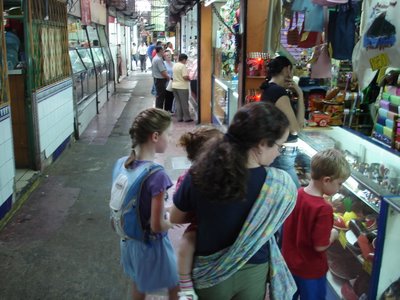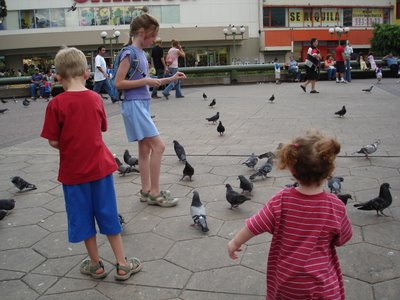San Jose
We needed to get out of the house today because the maid was coming, so we decided to go into San Jose and do the children’s museum again. From the time I woke up, I knew something wasn’t quite right with me. I felt achy and light-headed, and I didn’t have much of an appetite. It felt like I was getting the cold that Ramon had earlier. I forced down some oatmeal and took some Tylenol.
On the way to catch a taxi, Chino passed by (he’s the friend of Maritza’s that operates his own pirate taxi service). Cristina flagged him down and asked him if he could give us a ride, so we had Chino take us to the museum. Unfortunately, we got all the way there to find out that it was closed on Mondays. Fortunately Chino hadn’t driven off yet, so we quickly formulated a plan B and asked Chino to drop us off at the Mercado Central.
The Mercado Central is a massive, indoor, labyrinthine market that takes up a whole city block. It’s a maze of booths and shops selling everything from pots and pans to fresh fish. It’s kind of crazy, a bit claustrophobic at times (especially if you’re 6’3”) and the place can sometimes smell a bit unpleasant. But it’s one of those San Jose places that has to be experienced at least once per trip, so today may as well be the day.
At one of the booths, we noticed some whip-like twists of white-colored leather. Cristina asked the vendor what they were. Bull penises, of course. What else? They stretch them out, wrap a cord around them (making the twisted shape, like a rotini pasta), dry them out, and then lacquer them. They are used as whips for horses, and Japanese tourists buy them a lot too. The surreal moment of the day had to be my wife trying to help this old man pronounce “bull penis” in English.
We looked around the central market for a good hour or so, then headed to the Plaza De La Cultura. We were getting a little hungry, so we asked a couple of cops in the Plaza where a good restaurant, not fast food, could be found. They recommended a Chinese place just around the corner, so we headed there. When we peeked in the door, I noticed a large round table surrounded by Asians. That seemed like a good sign to me, so we decided to eat there.
Since we had time to kill, we were in no hurry. So it worked out that the food didn’t come very quickly. It was quite good, although we didn’t actually order Chinese food. Just the old “plate of the day.” I got fish with mine, and everyone else got chicken. They were disappointed to find that it was fried chicken wings. No one in my family likes chicken wings but me. I ate some of Alex’s, but with my cold, I didn’t have the appetite to eat everyone’s.
The Asians, meanwhile, were doing the whole huge spread. Lazy susan in the middle, soup, tea, entrees, cigarettes, and newspapers. Sofia noticed that they were all boys. They looked rather tired and were reading Asian newspapers, so I guessed that they had just arrived in the country and had jet lag. I couldn’t quite place what nationality they were. A couple of them looked Vietnamese, a couple definitely looked Japanese, and some looked Chinese. When they left and the waiter cleared their table, I noticed that on one of their plates there was a rooster head. I pointed it out to the kids and they thought it was gross.
After lunch, we walked back to the Plaza to check on the prices of the Gold Museum, which is located underground beneath the Plaza. I was ready for a nap, so the last thing I wanted to do was walk around a museum for an hour or more. Besides, we did the Gold Museum in 1998 with Damian and Lisa. Prices were 1000 colones for Cristina, $6 for me (3000 colones) and the kids were free. Cristina wanted to take the kids, so I opted to hang out in the lobby and maybe snooze a little. The ticket seller studied Cristina’s cedula, as if checking it for a fake, which we found curious and amusing.
I sat on a comfortable leather bench and nodded off intermittently between watching tour groups come and go. Cristina and the kids spent over an hour in the museum and had a great time.
She reported that there were 3 different sections: the currency exhibit, an exhibit of watercolor paintings done by Ticos, and the gold museum. Interestingly enough, there was heavy security watching every section of the museum closely. She took the kids through the watercolors fairly quickly, then proceeded into the Gold section, which included a lot of details on the pre-Columbian cultures that were present in this area before Columbus discovered this land on his fourth voyage across the Atlantic. There was a small section on the matriarchal elements of these cultures and the crafts that show this, mostly statues. Then it followed into the early beginnings of these cultures, like what foods they ate, the things they grew, what they hunted during different periods of their development. There was a display on archeology and the importance of not grave robbing. There were examples of a grave with its offerings and you could enter the half hut with all its household items.
After all this information on the tribes and how they functioned, they finally came to the section for which the museum is named. It began with the two different methods used to work with the gold. The first was warming the gold enough to hammer it flat for wearable ornaments. The other was casting the figures, mostly animals. Throughout the whole gold section there were examples of the figures and ornaments. At this point, there was an interactive display with pictures of different animals and an example of the corresponding gold figure. When the kids pressed on the correct buttons a light would shine on the corresponding stuffed animal. Then there was a small room where everything was touchable. It had examples of how pottery is made and rubbings the kids could do of pre-Columbian design shapes. After that they went to the currency exhibit. It was fairly small and showed examples of the Costa Rican colon through the ages. It was mentioned that cocoa beans were once used for money very long ago. At the end, one of the attendants had coins, some as old as 400 years for the kids to hold. There was also a coin press thing that has the design to put on the metal. They were finally done.
We had stashed a couple of dinner rolls from the restaurant to feed the pigeons at the Plaza. Isabella especially had a great time throwing bread crumbs to the birds. Once Alex finished his bread, he started chasing the pigeons, so we moved on.
The kids had behaved well in the museum, so we rewarded them with some ice cream. Sofia got a double scoop cup of lemon and strawberry. Alex got a small cup of chocolate. Cristina had a triple scoop cone of banana, mango, and chocolate. I still felt yucky, so I just watched them eat.On the pedestrian street, a trio of black guys played calypso music. One guy was working the crowd for donations. When we told him we didn’t have any money, he gestured to Alex with a smile and said, “You can just leave him with us!”
We cut through Universal, a big department store, to the other side of the block (Alex was amazed that we cut through the store and came out on a new street) and went to Joyeria Leonardo Da Vinci, a jewelry store that Cristina and her parents have gone to for over 30 years. The owner recognized Cristina, made pleasantries, and asked how her parents were doing. Cristina arranged for a pair of her pearl earrings to be repaired (she got them there) and she ordered two similar pairs for Sofia and Isabella. They would be ready on the 6th of July.
We caught a taxi to the Coca-Cola, then waited in line for the Pavas bus. It didn’t take long and soon we were back home. Maritza made a dinner of garlic and onion chicken, potatoes, and rice. It was very good, even though I still didn’t have much of an appetite.




0 Comments:
Post a Comment
<< Home